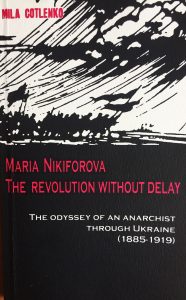 Strangely neither Volin, nor Archinov, not to mention other historians like Skirda or Avrich, ever gave Maria Nikiforova a place in their narratives, while Makhno himself recounts multiple episodes which shed some light on her activities. For an anarchist who lived during this revolutionary period in Ukraine, it becomes hard not to notice her: she was without a doubt a key figure of this period. Heading a deployment of Black Guards, supported by many workers of Alexandrovsk, a city next to Gulyai-Polye, her native town, but also by the sailors of Kronstadt, her qualities as a speaker as well as her practical capacities quickly confirmed her reputation throughout the entire Ukrainian territory. Firmly convinced that the ongoing revolutionary process needed to be deepened, she was not deterred by the established relationships of power from challenging the local authorities, even so-called “revolutionary” ones, from demanding contributions from the bourgeoisie and landlords, or from expropriating weapons, food, money and buildings…, which quickly caused her to be pilloried as an “anarcho-bandit” by the Bolshevik authorities.
Strangely neither Volin, nor Archinov, not to mention other historians like Skirda or Avrich, ever gave Maria Nikiforova a place in their narratives, while Makhno himself recounts multiple episodes which shed some light on her activities. For an anarchist who lived during this revolutionary period in Ukraine, it becomes hard not to notice her: she was without a doubt a key figure of this period. Heading a deployment of Black Guards, supported by many workers of Alexandrovsk, a city next to Gulyai-Polye, her native town, but also by the sailors of Kronstadt, her qualities as a speaker as well as her practical capacities quickly confirmed her reputation throughout the entire Ukrainian territory. Firmly convinced that the ongoing revolutionary process needed to be deepened, she was not deterred by the established relationships of power from challenging the local authorities, even so-called “revolutionary” ones, from demanding contributions from the bourgeoisie and landlords, or from expropriating weapons, food, money and buildings…, which quickly caused her to be pilloried as an “anarcho-bandit” by the Bolshevik authorities.
Entire periods of her life that are still largely unknown. These link her youth to “motiveless terror” (bezmotivnyi) around 1905 and to the insurrectional days in Petrograd in July 1917, launched by some comrades before the coup d’état of October. It also connects us to her participation in the “Underground Anarchists” who, after 1919, reconnected networks of comrades to attack targets among both the Whites and the Reds, calling out through their agitation for a “third social revolution”.
Beyond the enthusiasm that her life naturally arouses, in this text, we will not dress Maria Nikiforova up as a saint or heroin, as sometimes the anarchist movement remembers its dead. Already enough nightstand books exist to make amends with the past, pleased with placing one more figure to the pantheon of anarchists or of great women, before falling asleep. Because if it’s not to nourish the reflections and the struggles of the present, why is it necessary to immerse ourselves in the lives of the comrades that preceded us? Seeking to create a counter-history without bumps in the roads can lead to the same pitfalls as the official history, depriving individuals of their complexity and of their uniqueness, transforming them into myths. Even if written from the point of view of the dominated and the rebels, it can still end up freezing situations, transforming a living process into fate, erasing the debates and other possible choices, and replacing them with a chain of inevitable events.
Therefore the idea of this book is not to fit Maria Nikiforova in the role of an “Atamansha” (charismatic military leader) or a “Joan of Arc of anarchy”. It is precisely on this point that we need to be critical, because there is a high price to pay for this fame.
Maria Nikiforova’s role in the Ukrainian Revolution, as well as her own life story, were anything but well-trodden paths. In many key moments, she made choices with her ideas as her only guide, true decisions for which she took full responsibility. Though she eventually fell during this unequal fight, the fact remains that she left a possibility open: more than just living without renouncing one’s own ideals, she sought to live without measure to see them exist.
165 pages / 5 euros